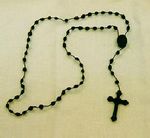
Back Rosenkranz ALS المسبحة الوردية Arabic المسبحه الورديه ARZ Rozari Azerbaijani Rožončios BAT-SMG Rosaryo BCL Ружанец BE-X-OLD তসবিহ (জপমালা) Bengali/Bangla Rosari Catalan Rosaryo CEB

| Part of a series on the |
| Rosary of the Catholic Church |
|---|
 |
| Overview |
| Prayers and promises |
| Writings |
| People and societies |
|
|
The Rosary[1] (/ˈroʊzəri/; Latin: rosarium, in the sense of "crown of roses" or "garland of roses"),[2] formally known as the Psalter of Jesus and Mary[3][4] (Latin: Psalterium Jesu et Mariae), also known as the Dominican Rosary[5][6] (as distinct from other forms of rosary such as the Franciscan Crown, Bridgettine Rosary, Rosary of the Holy Wounds, etc.), refers to a set of prayers used primarily in the Catholic Church, and to the physical string of knots or beads used to count the component prayers. When referring to the prayer, the word is usually capitalized ("the Rosary", as is customary for other names of prayers, such as "the Lord's Prayer", and "the Hail Mary"); when referring to the prayer beads as an object, it is written with a lower-case initial letter (e.g. "a rosary bead").
The prayers that compose the Rosary are arranged in sets of ten Hail Marys, called "decades". Each decade is preceded by one Lord's Prayer ("Our Father"), and traditionally followed by one Glory Be. Some Catholics also recite the "O my Jesus" prayer after the Glory Be; it is the best-known of the seven Fátima prayers that appeared in the early 20th century. Rosary prayer beads are an aid for saying these prayers in their proper sequence.
Usually, five decades are recited in a session. Each decade provides an opportunity to meditate on one of the Mysteries of the Rosary, which recall events in the lives of Jesus Christ and his mother Mary.
In the 16th century Pope Pius V established a standard 15 Mysteries of the Rosary, based on long-standing custom. This groups the mysteries in three sets: the Joyful Mysteries, the Sorrowful Mysteries, and the Glorious Mysteries. In 2002, Pope John Paul II said it is fitting that a new set of five be added, termed the Luminous Mysteries, bringing the total number of mysteries to 20. The mysteries are prayed on specific days of the week; with the addition of the Luminous Mysteries on Thursday, the others are the Glorious on Sunday and Wednesday, the Joyful on Monday and Saturday, and the Sorrowful on Tuesday and Friday.
Over more than four centuries, several popes have promoted the Rosary as part of the veneration of Mary in the Catholic Church,[7] and consisting essentially in meditation on the life of Christ.[8] The rosary also represents the Catholic emphasis on "participation in the life of Mary, whose focus was Christ", and the Mariological theme "to Christ through Mary".[9]
- ^ Malgouyres, Philippe; Schmitt, Jean-Claude (2017). Au fil des perles, la prière comptée : Chapelets et couronnes de prières dans l'Occident chrétien. Paris: Somogy. ISBN 978-2-7572-1295-0. OCLC 1012611484.
- ^ Wedgewood, Hensleigh (1872). A Dictionary of English Etymology (2nd ed.). London: Trubner & Co. p. 544.
- ^ de Rupe, Alanus. De Dignitate Psalterii [On the Dignity of the Psalter] (in Latin).
- ^ de Montfort, Louis (1710). Le Secret de Rosaire [The Secret of the Rosary] (in French). La Rochelle, France.
- ^ Cross, Frank Leslie; Livingstone, Elizabeth A. (2005). The Oxford Dictionary of the Christian Church. Oxford University Press. p. 1427. ISBN 978-0192802903. Retrieved 29 April 2014.
The rosary was propagated by the establishment of rosary confraternities, which were increasingly under Dominican control; in 1569, Pius V gave the Dominican Master General exclusive control over them. As a consequence, until 1984 the blessing of rosaries came to be reserved for Dominicans or priests having special faculties. Besides the Dominican rosary, there are various other forms. The Servite rosary, for instance, has seven sections in memory of the Seven Sorrows of the BVM (Blessed Virgin Mary), each consisting of the Lord's Prayer and seven Hail Marys; it apparently dates from the 17th cent...
- ^ Casanowicz, Immanuel Moses (1919). Ecclesiastical Art in the United States National Museum. U.S. Government Printing Office. pp. 632. Retrieved 29 April 2014.
Rosary. Made of glass and composition beads. The full or greater Dominican rosary of 15 decades.
- ^ "The Rosary: A Sacred Tradition in Catholic and Benedictine Spirituality - The Lay Monastic". 10 February 2024. Archived from the original on 10 March 2024. Retrieved 10 March 2024.
- Popular Piety Besides sacramental liturgy and sacramentals, catechesis must take into account the forms of piety and popular devotions among the faithful. The religious sense of the Christian people has always found expression in various forms of piety concerning the church's sacramental life, such as the veneration of relics, visits to sanctuaries, pilgrimages, processions, the stations of the cross, religious dances, the rosary, medals, etc.
- ^ Thurston, Herbert. "The Rosary". Catholic Encyclopedia. Retrieved 16 May 2017 – via www.newadvent.org.
- ^ Schroede, Jenny (2006). The Everything Mary Book. p. 219. ISBN 1-59337-713-4.